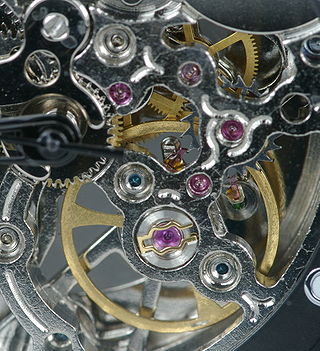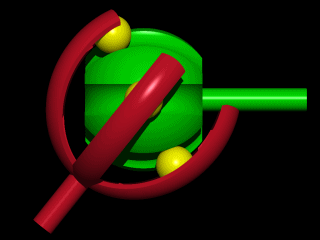Related Research Articles
A lubricant is a substance that helps to reduce friction between surfaces in mutual contact, which ultimately reduces the heat generated when the surfaces move. It may also have the function of transmitting forces, transporting foreign particles, or heating or cooling the surfaces. The property of reducing friction is known as lubricity.

Polytetrafluoroethylene (PTFE) is a synthetic fluoropolymer of tetrafluoroethylene and is a PFAS that has numerous applications. The commonly known brand name of PTFE-based composition is Teflon by Chemours, a spin-off from DuPont, which originally discovered the compound in 1938.

A ball bearing is a type of rolling-element bearing that uses balls to maintain the separation between the bearing races.

A bearing is a machine element that constrains relative motion to only the desired motion and reduces friction between moving parts. The design of the bearing may, for example, provide for free linear movement of the moving part or for free rotation around a fixed axis; or, it may prevent a motion by controlling the vectors of normal forces that bear on the moving parts. Most bearings facilitate the desired motion by minimizing friction. Bearings are classified broadly according to the type of operation, the motions allowed, or the directions of the loads (forces) applied to the parts.

A plain bearing, or more commonly sliding contact bearing and slide bearing, is the simplest type of bearing, comprising just a bearing surface and no rolling elements. Therefore, the journal slides over the bearing surface. The simplest example of a plain bearing is a shaft rotating in a hole. A simple linear bearing can be a pair of flat surfaces designed to allow motion; e.g., a drawer and the slides it rests on or the ways on the bed of a lathe.

A flexure bearing is a category of flexure which is engineered to be compliant in one or more angular degrees of freedom. Flexure bearings are often part of compliant mechanisms. Flexure bearings serve much of the same function as conventional bearings or hinges in applications which require angular compliance. However, flexures require no lubrication and exhibit very low or no friction.

A jewel bearing is a plain bearing in which a metal spindle turns in a jewel-lined pivot hole. The hole is typically shaped like a torus and is slightly larger than the shaft diameter. The jewels are typically made from the mineral corundum, usually either synthetic sapphire or synthetic ruby. Jewel bearings are used in precision instruments where low friction, long life, and dimensional accuracy are important. Their main use is in mechanical watches.

In mechanical engineering, a rolling-element bearing, also known as a rolling bearing, is a bearing which carries a load by placing rolling elements between two concentric, grooved rings called races. The relative motion of the races causes the rolling elements to roll with very little rolling resistance and with little sliding.

A constant-velocity joint is a mechanical coupling which allows the shafts to rotate freely and compensates for the angle between the two shafts, within a certain range, to maintain the same velocity.

Rolling resistance, sometimes called rolling friction or rolling drag, is the force resisting the motion when a body rolls on a surface. It is mainly caused by non-elastic effects; that is, not all the energy needed for deformation of the wheel, roadbed, etc., is recovered when the pressure is removed. Two forms of this are hysteresis losses, and permanent (plastic) deformation of the object or the surface. Note that the slippage between the wheel and the surface also results in energy dissipation. Although some researchers have included this term in rolling resistance, some suggest that this dissipation term should be treated separately from rolling resistance because it is due to the applied torque to the wheel and the resultant slip between the wheel and ground, which is called slip loss or slip resistance. In addition, only the so-called slip resistance involves friction, therefore the name "rolling friction" is to an extent a misnomer.

Originally designed in 1966 by Leonard R Jordan Jr, the steering damper or steering stabiliser is a damping device designed to inhibit an undesirable, uncontrolled movement or oscillation of a vehicle steering mechanism, a phenomenon known in motorcycling as the death wobble. The stabilizer absorbs unwanted energy in the side to side motion allowing the forks and shocks to work properly. Many things can cause a motorcycle chassis to get upset such as slamming on brakes, rough road, and lastly improper setup. An upset chassis can be a great deal of danger for the rider often times resulting in a crash. A steering stabilizer slows those movements down resulting in the rider feeling more comfortable on the motorcycle.
Dry lubricants or solid lubricants are materials that, despite being in the solid phase, are able to reduce friction between two surfaces sliding against each other without the need for a liquid oil medium.
The exoskeletal engine (ESE) is a concept in turbomachinery design. Current gas turbine engines have central rotating shafts and fan-discs and are constructed mostly from heavy metals. They require lubricated bearings and need extensive cooling for hot components. They are also subject to severe imbalance that could wipe out the whole rotor stage, are prone to high- and low-cycle fatigue, and subject to catastrophic failure due to disc bursts from high tensile loads, consequently requiring heavy containment devices. To address these limitations, the ESE concept turns the conventional configuration inside-out and utilizes a drum-type rotor design for the turbomachinery in which the rotor blades are attached to the inside of a rotating drum instead of radially outwards from a shaft and discs. Multiple drum rotors could be used in a multi-spool design.
In mechanical engineering, a cam follower, also known as a track follower, is a specialized type of roller or needle bearing designed to follow cam lobe profiles. Cam followers come in a vast array of different configurations, however the most defining characteristic is how the cam follower mounts to its mating part; stud style cam followers use a stud while the yoke style has a hole through the middle.

The yaw system of wind turbines is the component responsible for the orientation of the wind turbine rotor towards the wind.

The yaw bearing is the most crucial and cost intensive component of a yaw system found on modern horizontal axis wind turbines. The yaw bearing must cope with enormous static and dynamic loads and moments during the wind turbine operation, and provide smooth rotation characteristics for the orientation of the nacelle under all weather conditions. It has also to be corrosion and wear resistant and extremely long lasting. It should last for the service life of the wind turbine) while being cost effective.

GGB manufactures self-lubricating, prelubricated plain bearings and tribological polymer coating for various industries and applications. It has production facilities in the U.S., Germany, France, Slovakia, Brazil and China.

Air bearings are bearings that use a thin film of pressurized gas to provide a low friction load-bearing interface between surfaces. The two surfaces do not touch, thus avoiding the traditional bearing-related problems of friction, wear, particulates, and lubricant handling, and offer distinct advantages in precision positioning, such as lacking backlash and static friction, as well as in high-speed applications. Space craft simulators now most often use air bearings and 3-D printers are now used to make air-bearing-based attitude simulators for CubeSat satellites.
A tolerance ring is a radially sprung ring that is press fitted between two mating components to act as a frictional fastener. They are flexible shims designed to fix two cylindrical parts together. The wavelike protrusions that run around the circumference of the ring generate a retention force to provide an optimal fit between the two mating components without the need for adhesive or excessive assembly force, simplifying the process for manufacturers. They allow for any misalignment caused by thermal expansion or excessive vibration. Tolerance rings can be used as bearing mounts and as a means of dealing with torque transfer, torque overload protection and axial slip between mating components. They are often used to isolate undesirable vibration in engines and electric motors, for noise-free mechanism operation in passenger vehicles and domestic appliances, where noise reduction has become a major trend in recent years. Modifications to tolerance rings can be made to tune the dynamic stiffness and, therefore, the frequencies that can be isolated.

The pitch bearing, also named blade bearing, is a component of modern wind turbines which connect the rotor hub and the rotor blade. The bearing allows the required oscillation to control the loads and power of the wind turbine. The pitch system brings the blade to the desired position by adapting the aerodynamic angle of attack. The pitch system is also used for emergency breaks of the turbine system.
References
- ↑ "Saint-Gobain and Norco Get Celebrity Thumbs-Up". Product Design and Development. 2012-06-01. Archived from the original on 2016-08-19. Retrieved 2016-05-12.
- ↑ "A sunny future: how Small bearings can make a huge difference in concentrated solar plants (2011)" (PDF). Sustainability Outlook: 35–36. Retrieved 12 May 2016.[ permanent dead link ]
- ↑ Sliney, H. E.; Jacobson, T. P. (January 1975). "Performance of graphite fiber-reinforced polyimide composites in self-aligning plain bearings to 315 C".
- ↑ "Saint-Gobain Components Drive Advances in Automotive Friction Control and Manufacturing Performance" (PDF). Industrial Products Purchase. Archived from the original (PDF) on 13 March 2013. Retrieved 12 May 2016.
- ↑ "Fuel Economy and CO2 Emissions Standards, Manufacturer Pricing Strategies, and Feebates" (PDF). Oak Ridge National Laboratory. Retrieved 9 June 2016.
- 1 2 "Enhancing Automotive OEMs". Bearings. 14 June 2012. Retrieved 9 June 2016.
- ↑ "Eurobike 2012: Featherweight dream bikes from Stevens and AX Lightness". Road Cycling UK. Retrieved 2016-06-09.
- 1 2 3 4 5 "Key Applications of Norglide Composite Bearings & Norslide Cable Liners in High-Performance Bicycles | Product Showcase". showcase.designnews.com. Archived from the original on 2016-08-07. Retrieved 2016-06-09.
- ↑ Publishing, Seattle. "Bicycle Paper.com :: News :: Riding Circles Around Old Standards". www.bicyclepaper.com. Archived from the original on 2016-06-25. Retrieved 2016-06-09.
- ↑ "Saint-Gobain shows Norglide off at Taipei Cycle Show". Bikebiz. Archived from the original on 2016-08-16. Retrieved 2016-06-09.
- ↑ "Publications" (PDF). www.iea.org. Archived from the original (PDF) on 2017-07-07. Retrieved 2016-06-09.